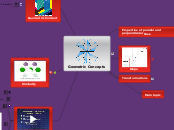af Melissa Mickelson 10 år siden
931
Geometric Concepts

af Melissa Mickelson 10 år siden
931

Mere som dette
Goal:
The student will demonstrate the ability to solve mathematical and real-world problems using measurement and geometric models and will justify solutions and explain processes used. The student will represent and analyze two- and three-dimensional figures using tools and technology when appropriate.
Levels are not age dependent
advancement through the levels requires geometric experiences.
The objects of thought at level 4 are deductive axiomatic systems for geometry.
The objects of thought at level 3 are relationships between properties of geometric objects.
The objects of thought at level 2 are the properties of shapes.
*Students can develop relationships between these poperties
The objects of thoughts at level 1 are classes of shapes rather than individual shapes.
The objects of thought at level 0 are shapes and what they "look like"
Figures shown in the same color are similar Two geometrical objects are called similar if they both have the same shape, or one has the same shape as the mirror image of the other.
To introduce the idea, consider the grid on the right. The columns of the grid are lettered A,B,C etc.The rows are numbered 1,2,3 etc from the top. We can see that the X is in box D3; that is, column D, row 3.
D and 3 are called the coordinates of the box. It has two parts: the row and the column.There are many boxes in each row and many boxes in each column. But by having both we can find one single box,where the row and column intersect
study of properties of shapes in 2d and 3d
Box or Cube:
V=l X w X h
Cylinder:
V = πr2h
The Area of a Circle is:
A = π × r2
Area of a Polygon: A=bh (base X height)
perimeter: all sides added together